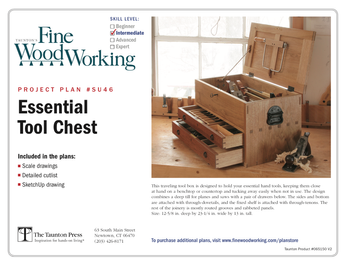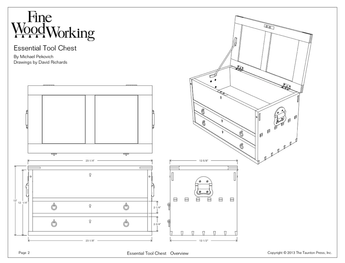A couple of weeks ago I bought a “Black Jack” No5 plane for 15 Euros (call it $20).
The plane was new and boxed. It has a 50 degree iron and a corrugated sole. The finish on the blade was terrible. The sole seems to be flat but the machining could be better – nothing a run through the sandpaper grits won’t fix.
Yesterday I lapped, ground and honed the blade. I took some test shavings on pine and beech.
Instead of curling up the shavings are coming out as corrugated ribbons, something like //////////////
Is this normal for high angle planes or do I have more work to do? 🙁















Replies
Yes. It's called a Type II shaving and is the result of the high angle blade, similar to that of a scraper. As you know, lower angles produce a curly shaving known as Type I.
and www.flairwoodwork.spaces.live.com)
- Success is not the key to happiness. Happiness is the key to success. If you love what you are doing, you will be successful. - Albert Schweitzer
Well howabouthat...we must have been typing at the same time.
But I think you are not correct-must I take some photos of a high angle bevel down planing some smooth shavings?Philip Marcou
Edited 8/16/2009 1:28 am by philip
Philip,While you are correct that the shavings could be caused by them being compressed, possibly hung up by the cap iron or lever cap, or trapped by your hand, I have experienced wavy shavings from a 50 degree blade on a 12 degree bed (62 degree effective cutting angle), though not as wavy as the OP's "illustration" showed.So to the OP, if your wavy shavings come out smoothly and easily, I would say that they are a type II shaving. If they suddenly spring out (sometimes they literally jump out of the throat of the plane), then it is due to the shaving being trapped.Chris @ http://www.flairwoodworks.com and http://www.flairwoodwork.spaces.live.com)
- Success is not the key to happiness. Happiness is the key to success. If you love what you are doing, you will be successful. - Albert Schweitzer
'Ere! Must I now show you pictures of a certain plane making long smooth shavings when the cutting angle is 60 degrees?
But I understand what you are saying, nonetheless.....Philip Marcou
Philip,Now that we know exactly what the OP's set up it, I concede that it is entirely possible to get curly shavings with a 50 degree effective cutting angle and believe you. With a 62 degree angle, that would be tough without skewing the plane severely.Chris @ http://www.flairwoodworks.com and http://www.flairwoodwork.spaces.live.com)
- Success is not the key to happiness. Happiness is the key to success. If you love what you are doing, you will be successful. - Albert Schweitzer
"With a 62 degree angle, that would be tough without skewing the plane severely."
Well it depends...... But have you seen the skirmishing going on in SawMillCreek where one side says that that skewing the plane does not reduce the cutting angle? (For the luv of de lord don't bring it here) (;)Philip Marcou
I have not heard that. I know where I stand on that issue. I'll leave it at that.Chris @ http://www.flairwoodworks.com and http://www.flairwoodwork.spaces.live.com)
- Success is not the key to happiness. Happiness is the key to success. If you love what you are doing, you will be successful. - Albert Schweitzer
Hah. The last incarnation of that argument I saw was on Woodnet. There are about a dozen subjects that just make my eyes glaze over these days, because of the deja vu factor. ;)
Actually that is where I saw the discussion last-not Saw Mill Creek. But it seems to have disappeared-must have been axed by the police-doesn't take much much to get them excited over there.....Philip Marcou
It is not normal-you should get a smooth continuous shaving.
That concertina shaving (;) happens because the shaving is not allowed to pass through the mouth easily, it is being compressed,could be that there isn't enough space between the back iron and the leading edge of the mouth, for example, or that shape of the back iron/chip breaker is not right. Can the frog be moved back-does it even have a moveable frog? You might just have to do some filing-maybe the front of the mouth is not sloping forward enough, or there is paint or rough edges at the mouth.
It can also happen if there is blade chatter, in which case you need to make sure the cause(s) are eliminated as far as possible.
What sort of surface finish are you getting?
Helluva thing, these budget planes (;)Philip Marcou
Edited 8/16/2009 1:34 am by philip
Philip,
Now, there is nowt like an experiment or two to see what actually happens.....
So, here are three pics taken of shavings made with 3 different Marcou planes (50, 55 & 62 degrees in that order) on the same piece of beech. The beech is well-behaved but the cuts were all taken against rising grain at about 10 degrees. The planes and their blades are all equally well set up/sharp.
View Image
View Image
View Image
The concertina effect looks greatest on the 55 degree, not the 62 degree shavings! However, this seems to signify nothing as far as the finish on the planed wood is concerned, as in all cases it is smooth and without tear out.
However, the first cuts (at 50 and 55 degrees) were made with bevel down blades, so the blade as a whole presents steeply to the wood. The last cut was made with a bevel up plane having a steep bevel angle to get the 62 degree cutting angle; but the blade is at 20 degrees in the body of the plane.
It is my experience that steeper cutting angle BD planes are more inclined to make concertina shavings than are BU planes at the same cutting angle. I don't know why this should be but there it is. I also find that it's harder to push a BD plane with the same cutting angle as a BU plane (for the same thickness/width of shaving).
I suspect that something about the angle of the blade in the plane body is having effects at the edge. How, why and the physics is a mystery to me but perhaps we have a mechanically-inclined physicist amongst us, who could derive a theory.....?
Lataxe
Fascinating! Whodathunk?Chris @ http://www.flairwoodworks.com and http://www.flairwoodwork.spaces.live.com)
- Success is not the key to happiness. Happiness is the key to success. If you love what you are doing, you will be successful. - Albert Schweitzer
It looks likes my lady wedding dress.. Juat perfect..
Could the concertina effect be caused by:The shaving starts to curl but bumps into the front of the throat so gets diverted upwards then tries again..... ad infinitum or in this case, to the end of the cut.Ah well, if a Marcou plane does it then it can't be a bad thing.
Dave,
I do recall some very concertina'd shavings coming out of one o' them high angle BD planes but I cannae remember the circumstances for certain. Perhaps some further experiments with variations in the mouth-gap are called for, as I do have a suspicion that having the mouth set at "shaving-thickness + a few microns" tends to make more concertina-like shavings than those got with a wide open mouth .........
In any event, the wood is always well-smoothed so one has to ask: is it an issue?
Lataxe, who uses all shavings of every shape to light his stove (very good they are).
Sir L,"who uses all shavings of every shape to light his stove"I wish I could but mine are not thick enough.So thin they burn like flash paper and never make it to the kindling.
Like the garlic in "Wiseguys", they simply turned to liquid when they hit the heat. Just like that there gone...poof.... :)BB
Aye, that is interesting -but seriously: none of those shavings are what I know as compressed or concertina type shavings,just wavy shavings .I think the wood type might have an influence.
Must I now produce some concertina shavings?(;)
"In any event, the wood is always well-smoothed so one has to ask: is it an issue?"
You took the words right out of my mouth.Philip Marcou
Philip, Lataxe,My shavings looked like the ones in Lataxe's middle photo. I was not the one who first used the term "Concertina" which you seem to be using to describe a more extreme case.As I have not previously encountered this phenomenon I decided to ask. Up to now the perfect shaving has been a thin tightly wound spiral. I gather that these "crinkly ribbons" are OK and not a sign of something wrong with the plane or the technique.Which is refreshing in that it means that I am not wasting my time fettling this plane. I am planning a maple coffee table which will be surfaced with hand planes and I have a suspicion that I may need this plane as when I made a mirror frame from the same plank there were a couple of problem spots when I was planing the wood.
Firstly, is the bed 50 degrees, or was that the angle of the bevel on the blade when received? (I tend to think it was the latter!).
Secondly, does the blade have a cap iron, and if so, how close is it to the edge of the blade? (I suspect that you are veru close to the edge).
The wrinkly shaving could be a symptom of a shaving that has too little clearance. High beds tend to have less room that lower beds, so it is important that the cap iron does not further block the mouth (simple fix - pull it back).
The other possibility is that the mouth is too small. Again the shaving is catching and concertining. The fix is to pull the frog back a smidgeon at a time until the shaving smooths out.
Keep in mind that some woods are very short grained and do not "flow" as long grained woods will.
Regards from Perth
Derek
Looks like I was typing at the same time as you!
Regards from Perth
Derek
Yes, but I was assuming that the bed angle was 50 degrees instead of 45.
If the iron is bevelled at 50 degrees on a standard bevel down plane it no workee because there is negative clearance.....Philip Marcou
I did wonder about that! :)
Regards from Perth
Derek
Gentlemen,I am overwhelmed by yor response. Thanks.The bed is at 50 deg. I have ground the blade to 25 with a microbevel of 30.The surface on the beech is "good in parts" I think that in the not so good part the grain was (slightly) against me.I'll check the other points, hopefully post a couple of pics. As I said, so far I have only worked on the blade. The rest is all to do but who (except probably philip) could have resisted a $20 high angle No5?
dav,
In addition to the other suggestions, I'll add this:
Perhaps you are trying to take too thick a shaving. In my experience, high angled planes "like" thin shavings.
Perhaps the leading edge of the cap iron needs attention. If it isn't "sharpened" to a feather edge where it meets the plane iron, but ends in a small flat or ledge, or doesn't meet the iron perfectly (flat underside of cap iron against flat top of plane iron) shavings can hang up and crumple.
Ray
Ray,The shavings are not thick but your point about the cap is probably correct. I shall have to see how things develop as I work through the tune-up. I planned some more work for this evening but did not manage to get around to it.
This forum post is now archived. Commenting has been disabled